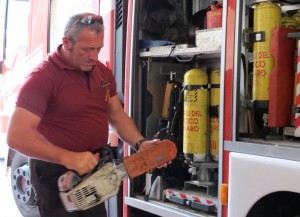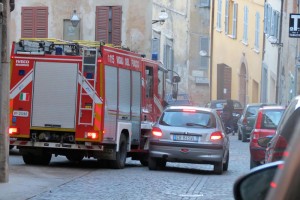Urbino’s fire department must use tiny trucks for a very big job.
URBINO, Italy – Rrriiiinnnggg!
The sound of a bell pierced the calm in the city’s fire house recently after a propane tank exploded in an apartment building in the center of town. One by one, firemen slid down the sleek, metal fire pole to the locker room, and in less than a minute they were tearing toward the blaze in a bright red fire truck.
This would be a routine call and scene for firemen all over the world, but things are different for Urbino fire fighters.
They fight blazes in a 500-year-old Renaissance city, a living museum of brick buildings filled with art treasures and built along narrow streets that climb and twist across an Apennine mountain top.
The situation calls for tiny, specially-built fire trucks. And specially trained fire fighters who often have to use tender loving care in subduing dangerous blazes.
“[If a historical building caught fire] we would use water and fire extinguishers,” said Fire Chief Claudio Ovarelli, speaking through an interpreter. “We have to pay attention to limit the damages,” added the fire chief who has worked for the Vigili Del Fuoco 28 of his 50 years.
Just getting to the scene of an Urbino fire call for special gear and training. Most U.S. fire trucks are 8 feet wide and 28 feet long, too wide and long for many of this city’s major streets. So Urbino’s fire trucks are sized for their habitat, with most measuring just 5 feet wide and 12 feet long.
But an equally serious challenge to fire fighters is finding a water source to combat flames. The city was founded long before underground plumbing. Retrofitting is difficult without damaging the historic buildings. For this reason there are very few hydrants inside the city walls.
“Unfortunately, [there are] only a few and underground, this is why you didn’t see them…in the historical center of Urbino we are not allowed to put them [in],” says Ovarelli
[pullquote]It’s very tough. Every day, we have training from six in the morning to eight at night.[/pullquote]
Fortunately, only half of the 1300 emergency calls his unit receives each year are for fires. And in a historic town made of brick, most of those involved are cars.
But like firefighters all over the world, the Vigili Del Fuoco is called out for natural disasters as well. In fact, last winter showed that snow can be equally treacherous to this city.
In January and February Urbino was buried under 13.12 feet of snow in the span of two weeks, a record that trapped residents in their homes and caused roofs to collapse.
“It was very messy,” said Chief Ovarelli. “We didn’t have the right equipment to deal with that situation.”
The storm was nicknamed “The White Earthquake” by the department because of the all the property damage. No one was hurt, and with the help of other public officials and student volunteers they were able to help rescue countless amounts of people.
Joining this group of first-responders isn’t easy. Anyone accepted after application must complete a rugged six-month training program at the central headquarters in Rome, passing both physical and classroom exams.
“It’s very tough,” says part-time firefighter Clara Corsini. “Every day, we have training from six in the morning to eight at night.
“In the morning we have theoretical classes like chemistry and math, then in the afternoons we have physical training with the equipment and also emergency medical training.”
Graduates are then assigned to a fire house, where the physical training continues on a daily basis for their entire career.
Chief Ovarelli explains that in the 1960s and 1970s only athletes, such as swimmers or rugby players, were accepted because they were the only ones who could handle the intensive program. He was a defensive tackle in the Italian league of American football, which helped prepare his body for the physical demands of the job.
In the Urbino Pesaro fire department six of the 40 firefighters are women, all of whom endured the intensive training process. Corsini, 30, a University of Urbino graduate and a seven-year veteran of part-time work with the Vigili del Fuoco said the hardest part of the training was proving a woman could handle the mental and physical demands of the job.
“It was tough at the beginning to be accepted by all of the men,” said Corsini, “but I proved that I was a tough girl, and now I am accepted by everyone.”
The same can’t be said of the townspeople. Corsini said that they often express shock at the sight of a woman dressed in the large boots and heavy helmets of a fire fighter. Even some people she rescues from life-threatening situations have to be convinced a woman saved them. When a man she pulled from a car wreck awoke at a hospital, he reportedly said: “I remember seeing a woman’s face in a fire helmet, but how could that be? Do I have a woman to thank for saving me?”
Becoming a firefighter in Urbino is very tough. The training is a long and intensive process, and the job itself is both physically and mentally demanding. The life of a firefighter is not an easy one, but it is a rewarding one, which makes it all worthwhile. “I love this job,” concludes Corsini. “I wouldn’t change it for anything.”
Multimedia

